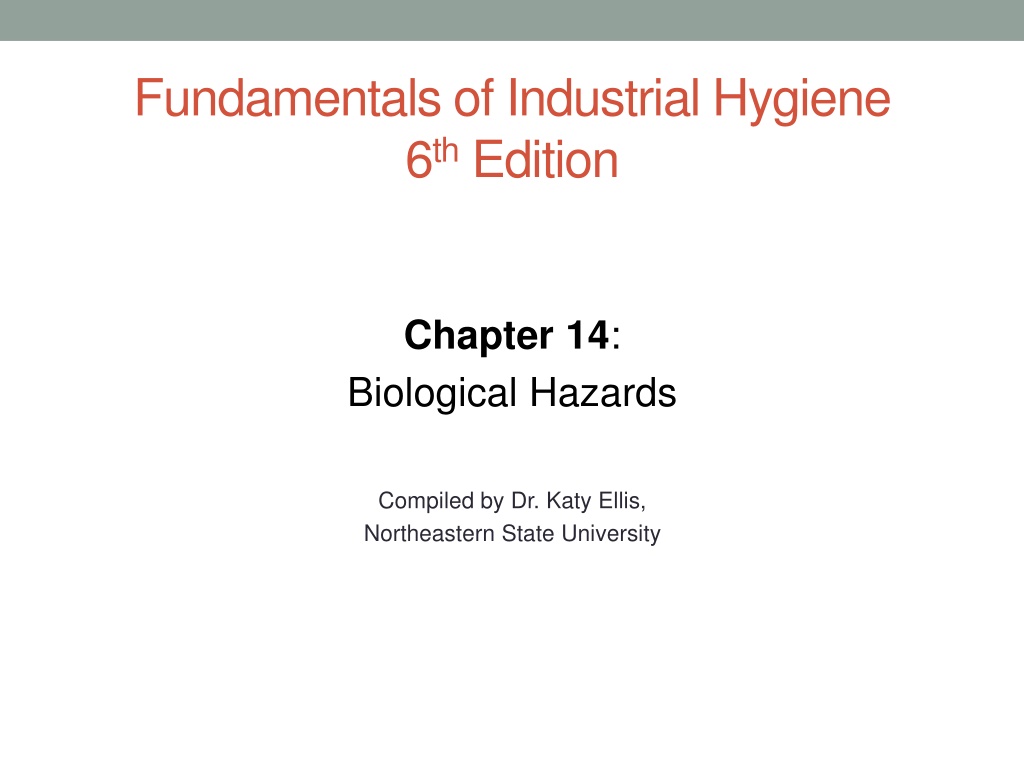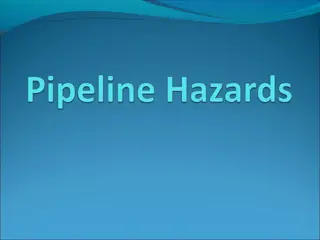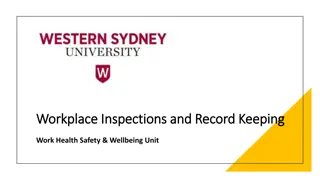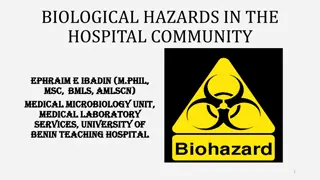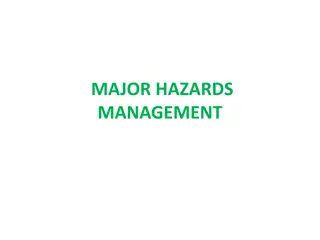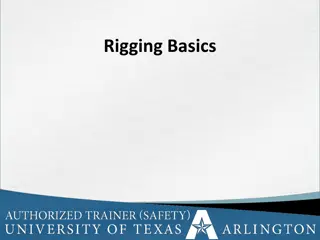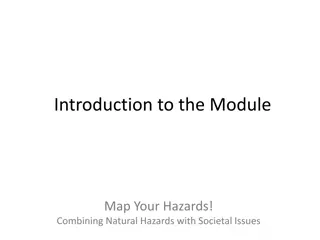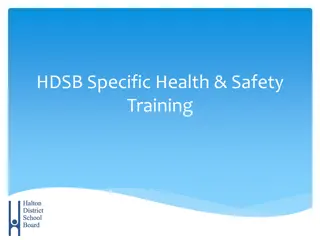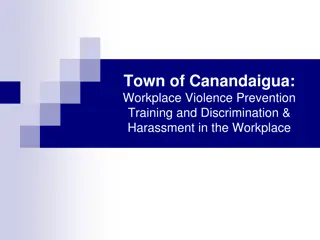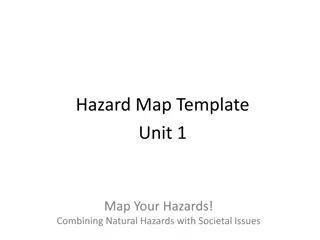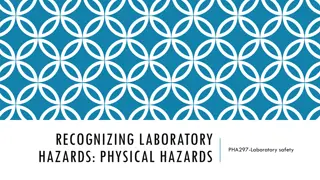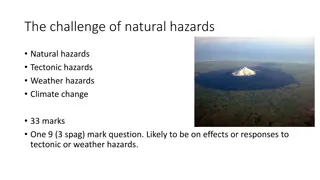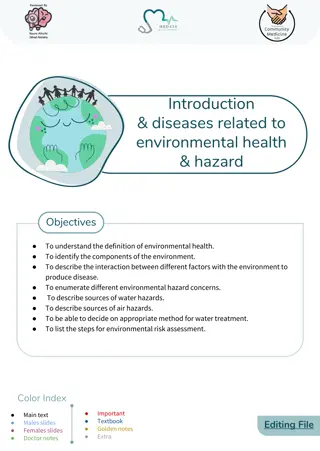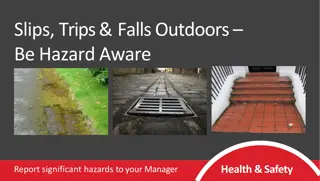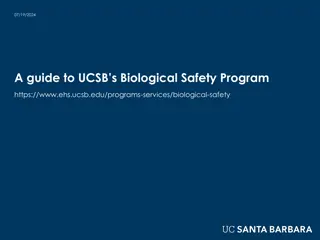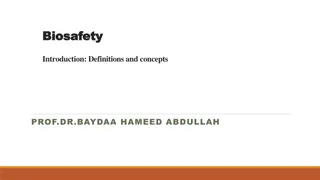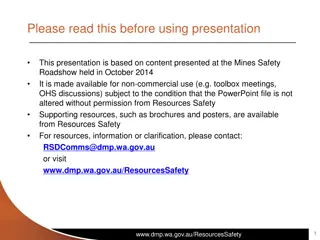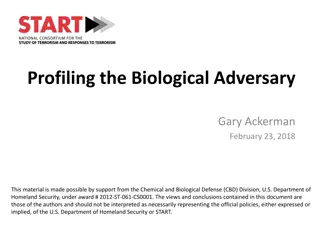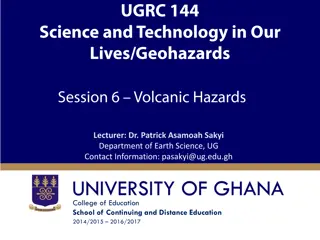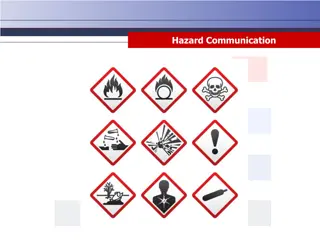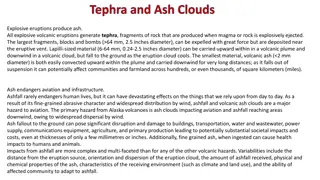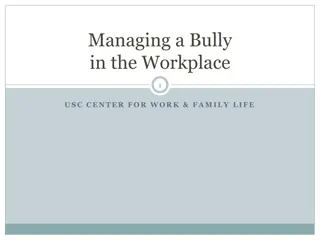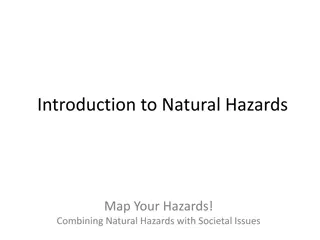Understanding Biological Hazards in the Workplace: A Comprehensive Overview
This chapter delves into the realm of biological hazards in occupational settings, shedding light on the risks posed by microorganisms, arthropods, allergens, toxins, and more. It highlights the diverse range of biological agents that can lead to infections, allergies, toxic reactions, and even serious illnesses among workers. The chapter emphasizes the significant population at risk worldwide and the importance of addressing these hazards to ensure a safe work environment.
Download Presentation

Please find below an Image/Link to download the presentation.
The content on the website is provided AS IS for your information and personal use only. It may not be sold, licensed, or shared on other websites without obtaining consent from the author. Download presentation by click this link. If you encounter any issues during the download, it is possible that the publisher has removed the file from their server.
E N D
Presentation Transcript
Fundamentals of Industrial Hygiene 6thEdition Chapter 14: Biological Hazards Compiled by Dr. Katy Ellis, Northeastern State University
Introduction The chapter provides basic information on those hazards that are considered biological in nature. The topic is extensive and cannot be completely addressed in a single chapter. One is encouraged to use the references and resources at the end of the chapter to gain more insight. Exposure to biological hazards in the workplace results in a significant amount of occupationally associated disease. The population at risk from occupational biohazards has been estimated to be several hundred million workers worldwide.
Introduction (cont.) Workers engaging in agricultural, medical, and laboratory activities are most at risk. About 193 biological agents are known to produce infectious, allergenic, toxic, and carcinogenic reactions in workers. Most of the identified bio-hazardous agents belong to the following groups: Microorganisms and their toxins Arthropods Allergens and toxins from higher plants Protein allergens from vertebrate animals Other groups
Microorganisms Microorganisms and their toxins (prions, viruses, bacteria, fungi, and their products); infection, exposure, or allergic reaction
Arthropods Arthropods (crustaceans, arachnids, and insects): bites or stings resulting in skin inflammation, systemic intoxication, transmission of infectious agents, or allergic reaction
Allergens and Toxins Allergens and toxins from higher plants: dermatitis from skin contact or rhinitis or asthma as a result of inhalation. Some toxins can be deadly.
Protein Allergens Protein allergens from vertebrate animals (urine, feces, hair, saliva, and dander): allergic reaction
Other Groups Other groups that pose potential biohazards include lower plants other than fungi (lichens, liverworts, and ferns) and invertebrate animals other than arthropods (parasites such as protozoa, flatworms such as schistosoma, and roundworms).
Biological Safety Organizations that handle dangerous pathogens need to manage their safety and security risks. Implement a unified biorisk management framework. Biorisk management is the combination of biosafety and biosecurity. Biological safety, or biosafety, as a discipline grew out of research involving biological warfare agents at Fort Detrick in Fredrick, MD. The containment principles developed there form the framework for the discipline of biosafety today. The principles and control methods used by biosafety specialists and industrial hygienists are similar: anticipation, recognition, evaluation, and control.
Biological Hazard Identification Microorganisms are a diverse group of microscopic organisms that includes bacteria, fungi, algae, protozoa, viruses, and prions. (Prions are the critters responsible for mad cow disease.) In addition to their ability to produce infectious diseases, microorganisms such as fungi produce spores capable of causing allergic reactions, or worse (anthrax) among workers.
Infection Infection is a general term applied to invasion of the body by microorganisms such as bacteria, protozoa, and the larval forms of multi-cellular organisms. It is further defined as an invasion of the body by pathogenic microorganisms and the reaction of the tissues to their presence and to the toxins generated by them. Individuals harboring communicable infectious agents without exhibiting signs of disease are called carriers. They can be a source of infection in co-workers, especially if the agent is transmitted by the aerosol route, as with measles or tuberculosis.
Infection (cont.) Infections from microorganisms not normally found in or on the human body, but which gain entrance from the environment, are called exogenous infections. (The opposite of which is endogenous infections.) These agents gain entry into the host by inhalation, indirect or direct contact, penetration, or ingestion. Some agents routinely cause disease in health adult humans, whereas others known as opportunists require special circumstances of lowered host defense or overwhelming dose of exposure. The end result depends on the virulence of the agent, the route of infection, and the relative immunity and health of the host.
Work-Associated Infections Defining the event or illness/infection, determining the population at risk, establishing the factors affecting exposure, and developing intervention controls are all part of the process to prevent occurrence or recurrence of infections. The Sulkin and Pike surveys revealed the most common routes of exposure: percutaneous inoculation (needles/syringes, cuts or abrasions from contaminated items, and animal bits); inhalation of aerosols generated by accidents or by work practices and procedures; contact between mucous membranes and contaminated material (hands and surfaces) and; ingestion. People engaged in research activities acquired the greatest number of infections.
Potentially Hazardous Workplaces Although most pathogenic microorganisms have the potential to cause occupationally acquired infections the following can reduce incidence: knowledge of the hazard containment practices and preventive therapeutic measures (e.g., vaccines) In workplaces where awareness of the hazard is high and the potential risk is understood (laboratories), compliance with control practices minimizes exposure. In some workplaces, controls are difficult to implement or are not readily available and hazard recognition is low.
Hazardous Workplaces Microbiology, public health, and molecular biology laboratories Exposures tend to be directly related to the hazard classification of the organisms being manipulated, the potential for release of the organism during required manipulations, and the level of competency of personnel. Staff in research laboratories tend to work with more hazardous agents, including those of emerging diseases. Hospitals and health care establishments Infections in hospitals can be categorized as community acquired; occupationally acquired; and nosocomial. The prevalence of hospital infections has created a need for infection control procedures (barriers), rigorous disinfection and sterilization techniques, meticulous cleaning and waste-handling procedures, and in some cases, special design criteria. The role of the industrial hygienist in hospital infection control may include assisting in the selection and testing of personal protective equipment, environmental testing in outbreak situations, and design and engineering controls such as ventilation and containment systems.
Hazardous Workplaces (cont.) Biotechnology facilities Workers can experience direct effects of the biological activity of an agent and develop allergies to proteins, other chemicals, animal dander or aerosolized urine proteins from animals. Animal facilities and veterinary practices During the past 50 years, zoonotic diseases have been among the most commonly reported occupational illnesses of laboratory workers. Most have been caused by viral and bacterial agents. Infection is most often the result of one of the following types of exposure: Animal bites or scratches Contaminated needle sticks or scalpels Infectious aerosols resulting from respiration, excretion, or infectious bedding Contact with infected tissues and cells during histological procedures, homogenization, or manipulation of cells in culture
Hazardous Workplaces (cont.) Agriculture,including mining and construction, are among the most hazardous occupations. Workers are exposed to numerous safety and physical hazards and chemical and biological agents. Workers are exposed to infectious microorganisms and their spores and toxins through inhalation of bioaerosols, ingestion resulting from contact with contaminated materials, direct exposure of non-intact skin and mucous membranes, and inoculation from traumatic injury. Factors such as host susceptibility, virulence, and dose all influence the development of disease.
Hazardous Workplaces (cont.) How do you reduce hazards when there are so many different occupational environments and situations? Engineering controls Administrative controls PPE Separate the human from the source. Prevent inhalation, absorption ingestion, and injection.
Risk Assessment It is possible to work with infectious agents and still avoid exposure. A series of circumstance are needed for an exposure to lead to infection. Pathogenicity understanding of the potential for the hazardous agent to cause human disease. Knowing what routes of infection the agent uses most efficiently permits you to make decisions about how to handle the risk. The risk assessment for the operation/event provides a systematic evaluation of the exposure and infection potential and the possible consequences. This leads to decisions on how the risk can be avoided, reduced, or managed. WHO Laboratory Biosafety Manual and the U.S. Biosafety in Microbiological and Biomedical Laboratories both emphasize risk assessment as the fundamental step for managing these risks.
Risk Assessment (cont.) Biological risk assessment is a two-step technical approach: 1) The hazard identification involving the characterization of the biological agents or materials and the evaluation of their potential impact 2) The result of the risk assessment informs the selection of the biological containment level, and other possible measures aimed at protecting the personnel, the community, and the environment Risk analysis consists of answering three specific questions: 1) What can happen? 2) What is the chance that it will happen? 3) If it happens, what are the consequences?
Risk Assessment (cont.) For biosafety, this can be broken down into three steps: 1) Identification of the biological agent or hazard and its unique biochemical properties; 2) Assessment of the probability of the hazard to cause an undesired event (exposure, disease, etc.) 3) Potential consequences and management of the risk through established control measures and reassessment if necessary
Exposure, Infection, Consequences In laboratories, the primary routes of exposure are Inhalation, percutaneous, ingestion Principal modes of transmission include contact transmission (direct or indirect), vector-borne transmission, and airborne transmission. Direct contact of an infected person with another person is rare in the laboratory environment, but such transmission occurs commonly in the community and in medical setting where patients are treated. Animal-to- human transmission through bites and scratches also occurs. Indirect transmission occurs when common environmental surfaces (such as equipment, workbenches, laboratory accessories) become contaminated, and the infectious material is transferred to a host. Vector-borne infection results when a causative agent is mechanically or biologically transmitted by a living vector such as a mosquito or tick, through a bite, directly through the skin, or by mechanical means, to the host. Airborne transmission is the inhalation of airborne infectious particles into the respiratory system. This is important in the transmission of certain pathogens such as Mycobacterium tuberculosis.
Exposure, Infection, Consequences (cont.) The routes of entry for microorganisms associated with occupationally acquired infection include inhalation, ingestion, penetration through skin (intact or nonintact), and contact with mucous membranes of the eyes, nose, and mouth. Many technical procedures, equipment, and spills in the workplace release microbes into the air, where they can be inhaled by workers. When contaminated objects such as hypodermic needles, broken glassware, and scalpels or animals puncture, cut or scratch the skin (percutaneous exposure) occurs. This type of exposure also occurs through skin surfaces that are not intact, that is, when open wounds, cuts, hangnails dermatitis, or eczema are present.
Exposure, Infection, Consequences (cont.) The infectious dose, or infective, dose is the number of microorganisms required to initiate an infection. Although there are data available from animal studies on ID50, only a modest amount of information exists for humans. Viability and virulence of the agent If a microorganism is not viable and able to replicate, the opportunity for infection does not exist. The external environment is critical in the replication of microorganisms. Temperature, humidity, and the presence or absence of growth factors or other chemicals all play an important role in viability.
Exposure, Infection, Consequences (cont.) Host susceptibility is often underestimated because the majority of persons working with potentially infectious material are healthy. Main host defenses are: the skin and the body s immune system. Other factors associated with risk assessment of microbial work include the ability to tolerate prophylactic or therapeutic measures (vaccines and effective interventions) and knowledge of the host range of the microorganism s potential for escape to the community. The importance of assessing the work activity (including the facility, contamination potential, volume of material, the type of work/manipulation being done, and the agent concentration) in relation to the host and agent cannot be overemphasized.
Exposure, Infection, Consequences (cont.) For an infection to occur: the agent must be pathogenic and viable; present in sufficient numbers to produce infection be transmitted successfully and delivered to a susceptible host at a suitable entry site.
Mitigation/Hazard Control Source control, minimization of accidental release, and protection of the worker reduces the risk of exposure to potentially infectious agents. Protect workers and the immediate work environment with good work practices and appropriate safety equipment. Effective vaccines can decrease worker risk. Protect of personnel outside the laboratory and in the community by using adequately designed, constructed, and maintained facilities and operational practices. Containment is the mechanism for ensuring workers outside of the immediate work environment and the community are protected or shielded from exposure due to infectious or biological agents. Specific mitigation measures should be selected based on the identified risks The biosafety guidelines most commonly used in the U.S. for containment of biohazardous agents in the workplace are those recommended by the CDC, The National Institutes of Health, and the National Research Council. Risk management is achieved through use of practices, facilities, and equipment specified in defined biosafety containment levels.
Mitigation/Hazard Control (cont.) Biosafety level 1 (BSL-1) Used for work involving defined and well-characterized strains of viable microorganisms of no known or minimal potential hazard to laboratory personnel or the environment. This level is appropriate for high school and undergraduates, and training laboratories. The laboratory is not separated from general building traffic, and work is conducted on the open bench. BSL-1LS Usedfor large-scale work (greater than 10 liters or production volumes). It is used for agents that can be handled at BSL-1 when they are at small scale.
Mitigation/Hazard Control (cont.) Biosafety level 2 (BSL-2) Used for work with many moderate-risk agents present in the community (indigenous) and associated with human disease of varying degrees of severity. Agents are usually of moderate potential hazard to personnel and the environment. This level is appropriate for clinical, diagnostic, teaching, and other research facilities in which work is done by individuals with a level of competency equal to or greater than one would expect in a college department of microbiology. BSL-2LS is used for large-scale operations with these agents.
Mitigation/Hazard Control (cont.) Biosafety level 3 (BSL-3) Used for work with indigenous or exotic agents where the potential for infection by aerosols is real and the disease may have serious or lethal consequences. Partial containment equipment such as, Class I or Class II biological safety cabinets, is used for all manipulations of infectious materials at BSL-3. There are special engineering design criteria and work practices associated with BSL-3 containment. BSL-3LS is used for large-scale operations.
Mitigation/Hazard Control (cont.) Biosafety level 4 (BSL-4) Used for work with dangerous and exotic agents that pose a high individual risk of life-threatening disease. Such an agent has a low infectious dose and poses a danger for the community from person-to-person spread. Maximum containment equipment, such as a Class III biological safety cabinet, or partial containment equipment in combination with a full-body, air-supplied, positive-pressure personnel suit is used for all procedures and activities. Laboratory access is strictly controlled. The facility is either separated from other buildings or completely isolated from other areas of the building.
Mitigation/Hazard Control (cont.) Biological Safety Cabinets (BSCs) Provide a primary barrier to prevent escape of infectious aerosols into the work environment. Three classes: Class I, Class II, and Class III. All classes have HEPA filters. Class II is the most commonly used. Selection of the class and type of cabinet must be based on the hazard level of the microorganism. To assure that a biological safety cabinet is functioning as designed, it must be certified on a regular basis. Horizontal or vertical flow clean benches should not be confused with biosafety cabinets they do not protect workers from exposure; they protect the work product from the worker.
Mitigation/Hazard Control (cont.) Work Practices Work practices are the most important component in preventing occupational exposure. There are seven basic rules of biosafety: 1) Do not siphon by mouth. 2) Manipulate infectious fluids carefully to avoid spills and the production of aerosols and droplets. 3) Restrict the use of needles and syringes to procedures for which there are no alternatives. 4) Use protective lab coats and gloves. 5) Wash hands after all laboratory activities. 6) Decontaminate work surfaces before and after use, and immediately after spills. 7) Do not eat, drink, store food, apply cosmetics, or smoke in the lab.
Mitigation/Hazard Control (cont.) Decontamination is the use of physical or chemical means to render materials safe for further handling by reducing the number of organisms present. Different from disinfection, a process that kills infectious agents outside the body. Neither of these terms should be confused with sterilization, which implies complete elimination or destruction of all forms of microbial life. The most frequently used disinfectants in the workplace include bleach (sodium hypochlorite) and isopropyl or ethyl alcohol, etc.
Mitigation/Hazard Control (cont.) Spill Management The management of spills in the laboratory usually consists of flooding the contaminated area with liquid disinfectant, being careful not to generate aerosols, cleaning up the spill, reapplying fresh disinfectant, and final clean up. Protective clothing is always worn. When spills involve large volumes of infectious agents, personnel should leave the area until aerosols have settled before cleanup is begun.
Mitigation/Hazard Control (cont.) Biosafety Program Management Treat all human blood and certain human body fluids as if they are infectious (universal precautions). Use engineering controls, work practice controls, PPE, sharps management procedures, labeling etc. Biosafety programs should include a mechanism to provide safety information to employees at all stages of their employment (new, altered work tasks, and long-term) as well as periodic safety updates. There should be an occupational health program with a four-fold purpose: To provide a mechanism to detect job-related illnesses To determine the adequacy of protective equipment and procedures and verify that hazardous agents are not being released into the general environment To establish baseline pre exposure status To assess the presence of preexisting conditions that would put an employee at increased risk
Current Topics in Biosafety Bloodborne Pathogens Hepatitis B virus is the most significant occupational infector of health care and laboratory personnel. This fact, coupled with the identification of HIV, prompted the development and implementation of measures that would promote worker protection. OSHA s publication of the standard for occupational exposure to bloodborne pathogens (1991) was the most significant regulation of work environments involved with potentially infectious materials to date. The standard applies to health care community and all occupations (such as emergency responders and morticians) in which there is a potential for microorganisms that may be present in human blood and body fluids and are capable of causing disease in human beings. Common Agents: Hepatitis A, B, C viruses HIV Tuberculosis
Current Topics in Biosafety (cont.) Bioterrorism Biological weapons are characterized by low visibility, high potency, and relatively easy delivery. There generally are not any warning properties to alert people and symptoms of exposure could take a few days to appear. Whereas a chemical agent usually includes acute symptoms in the persons near the site of exposure. Early recognition of the event is the key with rapid identification of the single or multiple agents. Allows a rapid response that potentially could save lives, increase the possibility of apprehending the perpetrators, and deny terrorists their goal of creating panic and crisis. Additional benefit is improvement in the ability of public health agencies to address infectious disease outbreaks, food safety concerns, and environmental hazards.
Current Topics in Biosafety (cont.) Recognition of a Bioagent Release Look for these clues: a large epidemic with greater case loads and more rapid onset than expected more severe disease than expected or an unusual exposure route a disease that is unusual for a given geographic area, found outside the normal transmission season, or in the absence of a normal vector multiple simultaneous epidemics of different diseases animal as well as human cases unusual strains or variants of an organism or one with uncommon resistance different attack rates in certain areas i.e., inside versus outside a building claims or evidence of agent release.
Current Topics in Biosafety (cont.) Response to a Bioagent Release The components of an epidemiological investigation of any disease outbreak are (a) documentation of who is affected; (b) identification of possible sources and routes of exposure; (c) recording of signs and symptoms of disease; and (d) rapid identification of the causative agent. Key elements of an effective response plan include prompt recognition of the incident, staff and facility protection, decontamination and triage of potentially exposed persons, medical therapy, and coordination with external emergency response an public health agencies.
Current Topics in Biosafety (cont.) Investigating Work- or Building-Related Illnesses Building-related illness (BRI) is a clinically diagnosed disease in one or more building occupants. It is distinguished from sick building syndrome (SBS), in which building occupants nonspecific symptoms cannot be associated with identifiable cause. The conditions and events necessary to result in human exposure to bioaerosols are: Presence of a reservoir that can support the growth of microorganisms or allow accumulation of biological material Multiplication of contaminating organisms or accumulation of biological material in the reservoir Generation of aerosols containing biological material Exposure of susceptible workers to the biological material
Current Topics in Biosafety (cont.) Steps involved in investigating work- or building-related biological hazards are identical to those for other industrial hygiene investigations: Identify the types of biological agents or materials that could cause the symptoms that affected people report. Conduct a walk-through inspection of the facility to find sources of the suspected materials or to observe mechanisms by which people could be exposed Interpret initial observations Collect samples from recognized sources to identify and quantify the material, if appropriate. Formulate recommendations to control identified problems, and outline a follow-up program to confirm problem resolution and to prevent a recurrence.
Current Topics in Biosafety (cont.) Walk through inspection to identify routes of disease transmission and sources of exposure. Reservoirs for infectious disease agents can be people or infected animals or the environment (e.g., cooling water contaminated with legionnaire s disease bacterium or bird droppings supporting the growth of the histoplasmosis fungus). Concentrate on identifying potential environmental reservoirs and aerosol- generating work practices when investigating cases of infectious or hypersensitivity. Some signs of biological contamination in buildings are the following: Water stains and evidence of standing water Slick or sticky biofilms on wet surfaces Algae or moss on surfaces that receive sunlight Cottony, wooly, or sooty fungal growth with or without colored spores on damp materials Odors such as moldy, mildew, musty, yeasty, sour, foul, spoiled, swampy, or earth odors Accumulated animal or plant debris, and signs of rodent, bird, or arthropod pests.
Current Topics in Biosafety (cont.) Personal protection for potential exposure to biological hazards IH and safety personnel who must inspect potentially contaminated equipment should request that the system be turned off (possibly locked/tagged out) while they examine it. Inspectors should wear disposable garments, slip-proof footwear, gloves, and eye protection. If there is a potential for the generation of aerosols during the inspection, wear appropriate respirator approved for the situation.
